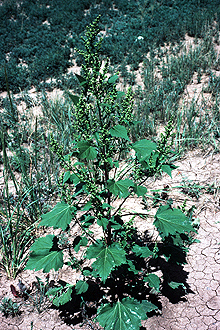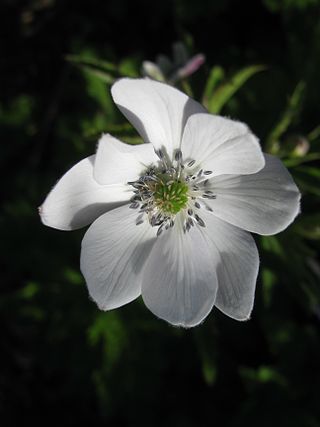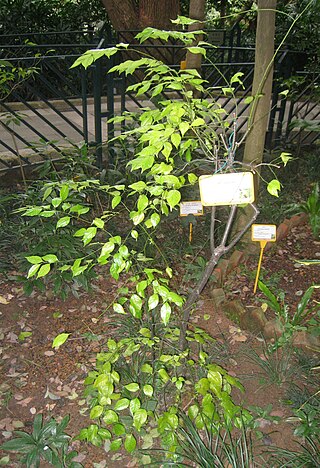
Pachypodium ambongense is a species of plant in the family Apocynaceae. It was first published as a species of the genus Pachypodium in 1924 by the botanist Henri Louis Poisson.

Pachypodium baronii, the Madagascar palm or bontaka, is a flowering plant in the family Apocynaceae. It has the habit of a robust shrub with a spherical or bottle-shaped trunk. It has several cylindrical branches at the top.

Pachypodium brevicaule is a species of plant that belongs to the family Apocynaceae.
Buddleja yunnanensis is a shrub native to Yunnan and much of the rest of south-western China, where it grows on forest margins, thickets, and along streams at elevations of 1,000 – 2,500 m. The shrub was first described and named by Francois Gagnepain in 1915. This species is distinct from and does not resemble Buddleja nivea var. yunnanensis, although sometimes the latter is erroneously labelled as B. yunnanensis.

Cyclachaena xanthiifolia, known as giant sumpweed, or rag sumpweed is a North American plant species in the sunflower family, Asteraceae. It is the only species in the genus Cyclachaena. Giant sumpweed is believed to be native to the Great Plains but is now found across much of southern Canada and the contiguous United States, though rarely in the Southeast.

Eriocapitella rivularis, a species of flowering plant in the buttercup family Ranunculaceae, is native to Asia. The specific epithet rivularis means "waterside, of the rivers", which evidently refers to one of its preferred habitats. It is commonly called the riverside windflower. In Chinese, it is called cao yu mei, which means "grass jade plum".
Van-royena is a genus of the plant family Sapotaceae described as a genus in 1963.
Goldbachia is a genus of flowering plants belonging to the family Brassicaceae.

Ilex asprella, also known as rough-leaved holly and plum-leaved holly, is a deciduous shrub native in South East Asia. Ilex asprella is one of the few deciduous species in the family Aquifoliaceae.

Prunus himalayana, called jyokun shin in Tibetan and 喜马拉雅臭樱 in Chinese, is a species of Prunus native to Nepal, Bhutan, Sikkim and Tibet. It prefers to grow 2,800 to 4,200 m above sea level in the Himalayas. As Maddenia himalaica it was the type species for the now unrecognized genus Maddenia.
Wuodendron is a genus of plants in the family Annonaceae and tribe Miliuseae, containing the type and only species Wuodendron praecox. It is distributed from northeastern India north to southern China and southeast through most of Mainland Southeast Asia.
Actinocarya is a small genus of annual herbs in the family Boraginaceae. Species in the genus are found in Pakistan, China, and India.

Itoa orientalis is a species of flowering plants belonging to the family Salicaceae. An evergreen tree from China and Vietnam, and cultivated as an ornamental tree.
Hedinia is a monotypic genus of flowering plants belonging to the family Brassicaceae. It only contains one known species, Hedinia tibetica.

Hewittia malabarica is a flowering plant in the monotypic genus HewittiaWight & Arn., belonging to the family Convolvulaceae and widespread throughout tropical Africa, Asia, and Polynesia. It is a climbing or prostrate perennial herb with slender stems and flowers that are pale yellow, cream, or white with a purple center, and large leaves that can be used as a cooked vegetable or used in folk medicine with the roots. The stems can be used to make ropes.
Zanthoxylum austrosinense, or South Chinese Sichuan pepper, is a woody plant in the family Rutaceae and is native to southern China.

Zanthoxylum avicennae is a woody plant in the family Rutaceae.
Zanthoxylum liboense (Chinese: 荔波花椒 is a plant in the Rutaceae family.
Zanthoxylum wutaiense is a woody plant from the family Rutaceae. It is native to Pingtung County, Taiwan.
Stenostephanus brevistamineus is a species of flowering plant first collected 11 July 2013 in Junín, Peru. Stenostephanus is a genus in the plant family of Acanthaceae. The species holotype is housed at HOXA, with isotypes at MO and USM.









